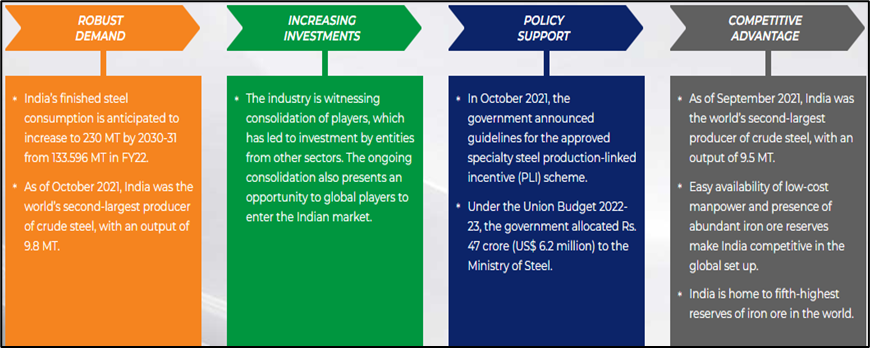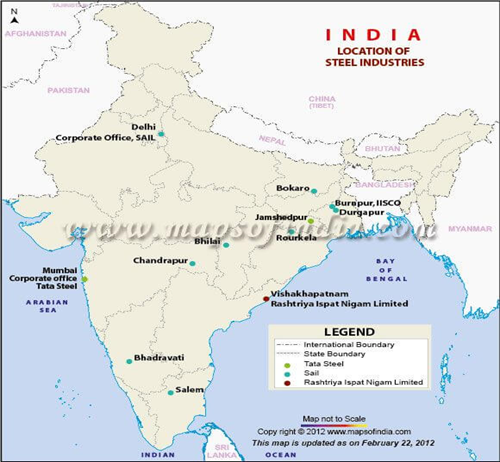In News:
- Recently, the Union Minister of Steel told Rajya Sabha that the government was considering mandating the use of “green steel” in government projects.
What’s in today’s article:
- India’s iron and steel sector
- Factors responsible for the location, distribution of steel industries in India
- About Green Steel
- News Summary
India’s iron and steel sector:
- Overview:
- India has now become the second largest crude steel producer in the world (after China).
- In the last 8 years, India has doubled its capacity to ~120 million tonnes of production and it is projected to grow five times in the next two decades.
- Per capita finished steel consumption in 2020 was 228 kg for the world and 691 kg for China and the same for India was 70 kg in 2020-21.
- Policy support:
- The Government has released the National Steel Policy 2017, which has laid down the broad roadmap for encouraging long term growth for the Indian steel industry, both on demand and supply sides, by 2030-31.

Factors responsible for the location, distribution of steel industries in India:
- Raw materials: For example, the abundance of iron ore in the Chota Nagpur region has resulted in a concentration of the iron and steel industry.
- Nearness to market is important: For instance, the Visakhapatnam steel plant, which is located near the shore, offers great import-export capabilities.
- Availability of cheap labour: The majority of the plants in the Chota Nagpur region benefit from an abundance of cheap labor.
- Availability of water: For example, Bokaro steel plant on the bank of river Damodar provides water for cooling.
- Nearness to Industrial Town: Mini steel plants that utilise scrap metals as input require waste metal recycling and are hence generally located near industrial areas.
- Government incentives: Like subsidies, tax rebates and capital, influences the location of industries. For example, Bhilai Steel Plant in Chhattisgarh was set up to remove the backwardness of the region.
- Availability of power and transport infrastructure.

The green steel:
- About: Essentially, green steel is the manufacturing of steel without the use of fossil fuels. This could help reduce the steel industry’s carbon footprint, helping countries to achieve their net-zero emissions targets.
- Ways of production: By using -
- Green hydrogen, which emits only water after burning and if it is produced via electrolysis using just water and renewable electricity, then it is completely free of CO₂ emissions.
- Electric arc furnaces
- Challenges:
- All steel can’t be green: According to a report by the NGO Global Energy Monitor, the shift from traditional blast furnaces (coal-based) to electric arc furnaces is “stagnant” and significantly behind decarbonization targets.
- Availability of green hydrogen
- The cost of green steel: The clean hydrogen production at scale will require billions of dollars of investment in renewable power generation.
- Way ahead:
- Speeding up the shift towards electric arc furnace steelmaking.
- Scaling up the technology to produce green or blue hydrogen.
News Summary:
- Emissions from the sector:
- The steel sector is extremely energy and resource intensive and is highly polluting. For example, India’s current average emission intensity is 2.55 tonne CO2, per tonne of crude steel, compared to about 1.95 tonne of global average.
- The emissions from the steel industry have been brought down by 15% between 2005 and 2022 and Centre targets an additional 10% reduction in emissions by 2030. Energy consumption per tonne of steel produced has also come down as well.
- Efforts by the Indian government:
- The government has put into place a short-term plan, as well as medium and long-term targets to deal with the issue.
- The short-term plan looks at reduction of carbon emissions through energy and resource efficiency in renewable energy.
- The medium-term plan (2030-47) looks at Carbon Capture Utilization and Storage as well as usage of possibly green hydrogen.
- And, the long-term plan (2047-70) looks at a complete move over from ore-based and coal-based to much more technological innovations to come down to net zero.









